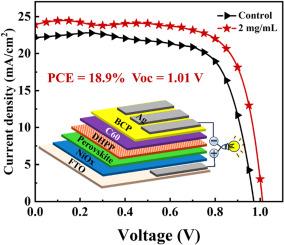Boosting stability and crystallization of Cs0.1FA0.8MA0.1PbI3 perovskites using organic passivation for efficient solar cells
IF 6.3
2区 材料科学
Q2 ENERGY & FUELS
引用次数: 0
Abstract
This study introduces an effective approach to enhancing the crystallization and stability of Cs0.1FA0.8MA0.1PbI3 perovskites by incorporating (+)-(3R,4R)-3,4-Dimethyl-4-(3-hydroxyphenyl) piperidine (DHPP) as a new passivation layer. The introduction of DHPP (2 mg/mL) into the perovskite film proves effective in various photophysical analyses. Characterization results show the formation of a stable α-phase (black phase), enlarged crystal domains, well-defined grain structures, and a smooth surface morphology, demonstrating a significant reduction in structural defects. Consequently, the optimized perovskite solar cells (PSCs) exhibit an open-circuit voltage (Voc) of 1.01 V and a power conversion efficiency (PCE) of 18.94 %. Moreover, the DHPP-treated devices retain over 90 % of their initial efficiency after 500 h in N2 filled Glove box, whereas the control devices deteriorate to 55 % and become non-functional. These results highlight the potential of DHPP passivation in promoting crystal growth, thereby enhancing both the stability and efficiency of organic-inorganic halide PSCs.

利用有机钝化技术提高Cs0.1FA0.8MA0.1PbI3钙钛矿在高效太阳能电池中的稳定性和结晶性
本文介绍了一种采用(+)-(3R,4R)-3,4-二甲基-4-(3-羟基苯基)哌啶(DHPP)作为新型钝化层提高Cs0.1FA0.8MA0.1PbI3钙钛矿结晶稳定性的有效方法。将DHPP (2mg /mL)引入钙钛矿膜中,在各种光物理分析中证明是有效的。表征结果表明,该材料形成了稳定的α-相(黑色相),晶域扩大,晶粒结构清晰,表面形貌光滑,结构缺陷明显减少。因此,优化后的钙钛矿太阳能电池(PSCs)的开路电压(Voc)为1.01 V,功率转换效率(PCE)为18.94%。此外,经过dhpp处理的装置在充满N2的手套箱中放置500小时后仍能保持90%以上的初始效率,而控制装置的效率则下降到55%,失去功能。这些结果突出了DHPP钝化在促进晶体生长方面的潜力,从而提高了有机-无机卤化物psc的稳定性和效率。
本文章由计算机程序翻译,如有差异,请以英文原文为准。
求助全文
约1分钟内获得全文
求助全文
来源期刊

Solar Energy Materials and Solar Cells
工程技术-材料科学:综合
CiteScore
12.60
自引率
11.60%
发文量
513
审稿时长
47 days
期刊介绍:
Solar Energy Materials & Solar Cells is intended as a vehicle for the dissemination of research results on materials science and technology related to photovoltaic, photothermal and photoelectrochemical solar energy conversion. Materials science is taken in the broadest possible sense and encompasses physics, chemistry, optics, materials fabrication and analysis for all types of materials.
 求助内容:
求助内容: 应助结果提醒方式:
应助结果提醒方式:


